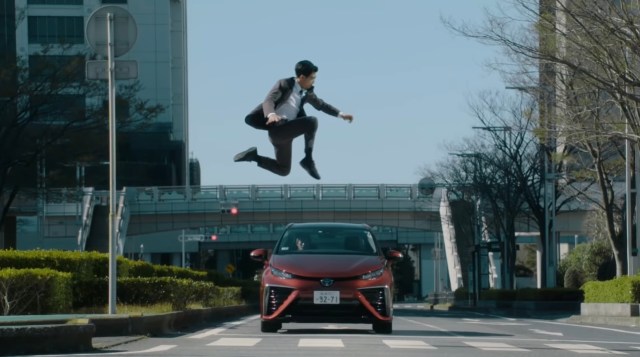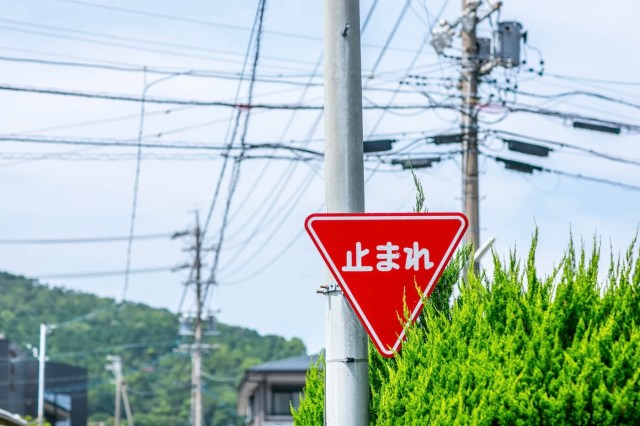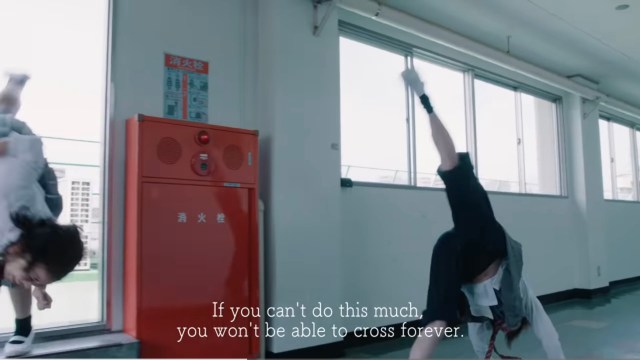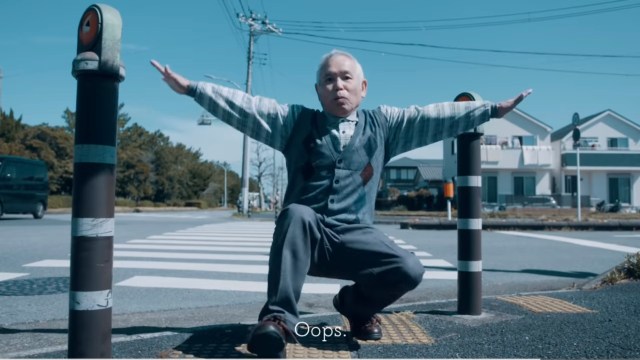
Is there anything ninja can’t do?
Since the ink on my Japanese driver’s license has yet to dry, I still have all the lessons ingrained from the rather grueling one year of studying and testing. So, while I’m still instinctively driving like a model product of the Osaka Prefectural Police, it’s even more glaringly obvious that a vast majority of drivers ignore a solid 50 percent of the rules and procedures I was taught were mandatory.
▼ I mean, what does “stop” mean really? The Earth is constantly spinning so we are never truly “stopped”, are we?

A prime example is pedestrian crossings. The rule, as I was taught, was that only in the event that no people are even in the vicinity of the crosswalk can you drive through at normal speed. In the case that a person doesn’t appear to be crossing but is moving along the same street as you near a crosswalk, you should reduce your speed enough that you can come to a sudden stop, which is generally said to be under 10 kilometers (6 miles) per hour but depends on the vehicle and conditions. And when a person is stopped at either end of the cross walk, you must stop your vehicle and wait for them to either cross or indicate to you that they are not crossing.
That was a mouthful, but it really is much easier done than said. And yet every time I’ve done it in real life, the pedestrian looks at me like a waiter whom I tipped $100 for a cup of coffee. What I did was certainly nice and appreciated but surprisingly out of step with conventional behavior.
This is because when using pedestrian crosswalks in many parts of Japan, you’d be wise to not expect the car to stop. In fact, a 2021 survey found that the chances of a car coming to a stop for you at a crosswalk is 30.6 percent based on the national average.
▼ News report from last year showing many cars not stopping, but those interviewed said things have been improving
The worst prefecture for this troubling trend is Okayama, where only 10.3 percent of cars stopped for pedestrians to cross. No prefecture wants to have the country’s crummiest drivers, so the Okayama branch of the Japan Automobile Federation, along with local businesses, tried out some awareness-raising campaigns to remind drivers to be kind and stop.
The most notable one was a video released by Toyota dealership Okayama Toyopet, titled Road to Ninja. This one-and-a-half minute short plays on an absurd stereotype that all Japanese people are ninjas but with the twist that in Japan you have to be a ninja just to cross the street safely.
In the video, students can be seen training in the importance of running fast and jumping high and one schoolgirl says matter-of-factly that you can’t cross the road here unless you’re a ninja.
Scenes also show people of all ages doing cartwheels and hurdling over zebra crossings to narrowly avoid the cars which stop for nothing. At the end, an elderly man deftly flips across the street. However, just after sticking the landing, he loses his balance and falls backwards into the street just as a car approaches.
The video then hits us with the sobering statistic that 32 percent of pedestrian crossing fatalities occur while the pedestrian is using a crosswalk. In other words, 32 percent of pedestrian deaths were caused by the driver ignoring the rules and not coming to a stop when a person is present.
It was a clever video that presented an important message with humor and got over 300,000 views since it was released last. But far more impressive is that since its release, Okayama traffic manners have improved drastically.
Last year’s survey by the JAF saw a promising improvement in crosswalk stopping from 30.6 percent to 39.8 percent nationwide. Among those results, Okayama shot up from last place in the country to 49 percent which is well above average. This left Tokyo in last place with 27.3 percent but that’s still up from 12.1 percent the year before, so they deserve a pat on the back too. Meanwhile, Nagano’s been crushing it with an over-80 percent rate for the past two years.
There’s no evidence to say that Okayama’s stellar improvement is the direct result of the video, but it certainly was the awareness campaign with the biggest impact during that year. In the end, it doesn’t really matter how we arrive at a society of more sensible driving practices, just as long as we get there and stop at crosswalks along the way.
Source: TV Asahi News, YouTube/Toyopet Okayama, JAF
Images: YouTube/Toyopet Okayama (Unless otherwise noted)
● Want to hear about SoraNews24’s latest articles as soon as they’re published? Follow us on Facebook and Twitter!



 Japanese survey finds only 23 percent of vehicles stop for pedestrians at crosswalks
Japanese survey finds only 23 percent of vehicles stop for pedestrians at crosswalks University of Tokyo lecturer suggests giving cars big cartoon eyes will make them safer
University of Tokyo lecturer suggests giving cars big cartoon eyes will make them safer Driver who killed cyclist in crosswalk accident found not guilty, causes controversy in Japan
Driver who killed cyclist in crosswalk accident found not guilty, causes controversy in Japan Harrowing video sees reckless drivers ignore pedestrian crossing in Japan【Video】
Harrowing video sees reckless drivers ignore pedestrian crossing in Japan【Video】 Simulation shows the chaotic consequences of walking in Shibuya while staring at your phone
Simulation shows the chaotic consequences of walking in Shibuya while staring at your phone How to order snacks on a Shinkansen bullet train in Japan
How to order snacks on a Shinkansen bullet train in Japan Japan’s new difficult-to-drink-from beer glass protects your liver, but it’s a brutal experience
Japan’s new difficult-to-drink-from beer glass protects your liver, but it’s a brutal experience Burger King Japan suddenly adds Dr. Pepper and Dr. Pepper floats to its menu nationwide
Burger King Japan suddenly adds Dr. Pepper and Dr. Pepper floats to its menu nationwide Demon Slayer: Kimetsu no Yaiba gets new roller coaster attractions and food at Universal Studios Japan
Demon Slayer: Kimetsu no Yaiba gets new roller coaster attractions and food at Universal Studios Japan Hello, cosmetics! Clinique teams up with Hello Kitty this summer for first-time collaboration
Hello, cosmetics! Clinique teams up with Hello Kitty this summer for first-time collaboration Kyoto Tower mascot termination reveals dark side behind cute Japanese characters
Kyoto Tower mascot termination reveals dark side behind cute Japanese characters Nintendo history you can feel – Super NES, N64, and GameCube controllers become capsule toys
Nintendo history you can feel – Super NES, N64, and GameCube controllers become capsule toys This Nara workshop has been making deer crackers for more than 100 years and offers tours【Photos】
This Nara workshop has been making deer crackers for more than 100 years and offers tours【Photos】 High-fashion Totoro cuddle purse is like an elegant stroll in the forest【Photos】
High-fashion Totoro cuddle purse is like an elegant stroll in the forest【Photos】 Legendary Melon Bread by Tokyo Banana returns after 20-year absence【Taste Test】
Legendary Melon Bread by Tokyo Banana returns after 20-year absence【Taste Test】 “The most Delicious Cup Noodle in history” – Japan’s French Cup Noodle wins our heart【Taste test】
“The most Delicious Cup Noodle in history” – Japan’s French Cup Noodle wins our heart【Taste test】 Starbucks releases a cute Frappuccino and Unicorn Cake…but not in Japan
Starbucks releases a cute Frappuccino and Unicorn Cake…but not in Japan McDonald’s Japan’s Soft Twist Tower: A phantom ice cream only sold at select branches
McDonald’s Japan’s Soft Twist Tower: A phantom ice cream only sold at select branches Yabai Ramen: What makes this Japanese ramen so dangerous?
Yabai Ramen: What makes this Japanese ramen so dangerous? Finally! Nintendo Japan expands Switch 8-bit controller sales to everybody, Online member or not
Finally! Nintendo Japan expands Switch 8-bit controller sales to everybody, Online member or not Japanese government wants to build luxury resorts in all national parks for foreign tourists
Japanese government wants to build luxury resorts in all national parks for foreign tourists To combat declining birth rate, Japan to begin offering “Breeding Visas” to foreigners
To combat declining birth rate, Japan to begin offering “Breeding Visas” to foreigners 10 things you should buy at 7-Eleven in Japan
10 things you should buy at 7-Eleven in Japan Studio Ghibli releases anime heroine cosplay dresses that are super comfy to wear
Studio Ghibli releases anime heroine cosplay dresses that are super comfy to wear Woman charged for driving suitcase without a license in Osaka
Woman charged for driving suitcase without a license in Osaka Studio Ghibli unveils My Neighbour Totoro miniature house model
Studio Ghibli unveils My Neighbour Totoro miniature house model Kyoto experiencing problems with foreign tourists not paying for bus fares, but not on purpose
Kyoto experiencing problems with foreign tourists not paying for bus fares, but not on purpose Fighting mild hunger with a Japanese soda that turns into jelly in the stomach【Taste test】
Fighting mild hunger with a Japanese soda that turns into jelly in the stomach【Taste test】 Studio Ghibli’s Howl’s Moving Castle tapestry unveiled in Japan for first time
Studio Ghibli’s Howl’s Moving Castle tapestry unveiled in Japan for first time McDonald’s new Happy Meals offer up cute and practical Sanrio lifestyle goods
McDonald’s new Happy Meals offer up cute and practical Sanrio lifestyle goods Sales of Japan’s most convenient train ticket/shopping payment cards suspended indefinitely
Sales of Japan’s most convenient train ticket/shopping payment cards suspended indefinitely Sold-out Studio Ghibli desktop humidifiers are back so Totoro can help you through the dry season
Sold-out Studio Ghibli desktop humidifiers are back so Totoro can help you through the dry season Japanese government to make first change to romanization spelling rules since the 1950s
Japanese government to make first change to romanization spelling rules since the 1950s Foreigner’s request for help in Tokyo makes us sad for the state of society
Foreigner’s request for help in Tokyo makes us sad for the state of society Ghibli founders Toshio Suzuki and Hayao Miyazaki contribute to Japanese whisky Totoro label design
Ghibli founders Toshio Suzuki and Hayao Miyazaki contribute to Japanese whisky Totoro label design Doraemon found buried at sea as scene from 1993 anime becomes real life【Photos】
Doraemon found buried at sea as scene from 1993 anime becomes real life【Photos】 Tokyo’s most famous Starbucks is closed
Tokyo’s most famous Starbucks is closed Princesses, fruits, and blacksmiths: Study reveals the 30 most unusual family names in Japan
Princesses, fruits, and blacksmiths: Study reveals the 30 most unusual family names in Japan Should you drive through a red traffic light like this in Japan? Confusing road rule explained
Should you drive through a red traffic light like this in Japan? Confusing road rule explained Japanese custom of bowing to cars at crosswalks keeps locals safe, warms Internet’s hearts【Video】
Japanese custom of bowing to cars at crosswalks keeps locals safe, warms Internet’s hearts【Video】 These “star marks” on the road in Japan that indicate when to use your blinker are amazing【Video】
These “star marks” on the road in Japan that indicate when to use your blinker are amazing【Video】 Man attempts to set himself on fire in middle of Tokyo’s busiest intersection【Video】
Man attempts to set himself on fire in middle of Tokyo’s busiest intersection【Video】 “Daaangerrrr!” Fukuoka town experiments with new road markings
“Daaangerrrr!” Fukuoka town experiments with new road markings Heroic bus driver prevents roadside suicide on bridge in China 【Video】
Heroic bus driver prevents roadside suicide on bridge in China 【Video】 Possibly the most considerate pedestrian crossing button ever installed
Possibly the most considerate pedestrian crossing button ever installed Japanese “street racer” grannie takes mobility scooter into street, blocks traffic, doesn’t care
Japanese “street racer” grannie takes mobility scooter into street, blocks traffic, doesn’t care “Conbini warp” an increasing traffic problem for businesses and authorities across Japan
“Conbini warp” an increasing traffic problem for businesses and authorities across Japan Japanese police officer pursues, pulls over Lamborghini supercar…while on a bicycle【Video】
Japanese police officer pursues, pulls over Lamborghini supercar…while on a bicycle【Video】 Anime’s Tetsuwan Atom/Astro Boy shows up on a pedestrian walk signal in Japan
Anime’s Tetsuwan Atom/Astro Boy shows up on a pedestrian walk signal in Japan Japanese YouTuber sleeps on a bed in the middle of Shibuya Scramble Crossing【Video】
Japanese YouTuber sleeps on a bed in the middle of Shibuya Scramble Crossing【Video】 Aichi Police refund over a million yen in fines to drivers who violated a misplaced traffic sign
Aichi Police refund over a million yen in fines to drivers who violated a misplaced traffic sign Traffic accident scammer caught on CCTV in China, ends up having to pay fine himself 【Video】
Traffic accident scammer caught on CCTV in China, ends up having to pay fine himself 【Video】
Leave a Reply